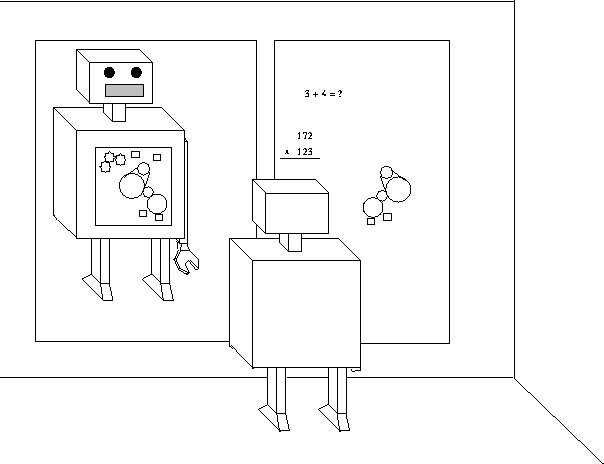Machine Self-Reference
The robot pictured below has a transparent front and is facing an (expandable) board, a little to its right, and a mirror, a little to its left. It's transparent front enables it to see in the mirror its complete underlying mechanism, flowchart, or program. The board serves for input, output, and intermediate computations. Such a self-referential or self-reflecting robot has data access, then, to a complete (low level) self model.
It is depicted already having copied onto the board a portion of its ``program'' (corrected for mirror reversal). Note that the robot's self copy is projected externally to the robot itself. In this way infinite regress is not required for the robot to have complete (low level) self knowledge. The use this robot makes of its complete (low level) self knowledge is whatever was built into it, but it could have been anything algorithmic.
For general computer programs, in contexts where mirrors may not be available, a quiescent (low level) self-model can be obtained by a mechanism logically similar to the self-replication mechanism employed by single-celled organisms. See the second reference under REPRESENTATIVE PUBLICATIONS below or click here for an brief essay of mine on the subject. For more information on self-replication mechanisms, see Moshe Sipper's Page on Machine Self-Replication. For connections to self-modification, see this link to the work of J-Paul Moulin.
I am interested in three aspects of machine self-reference.
-
(1) Its potential profound
philosophical importance as a model of perfect
(low-level) self
knowledge. In Western philosophy, self
knowledge is thought to
be important.
See
Greg Riccardi's paper from his doctoral dissertation and
Jim Royer's doctoral dissertation, each
done under my direction and referenced just
below, for some preliminary
attempts to mathematically understand what use is self
knowledge. In these works machine self-reference is treated as a
(connotational) control structure. For example, the Royer reference presents
the result that, as control structures, neither self-reference
nor if-then-else can be built solely
from the other, but together they enable
the construction of any control structure: self-knowing and
decision-branching are complementary.
On my
Computational Learning Theory page,
control structures are also mentioned --- click
here
to see the reference there.
For more recent attempts to understand mathematically the power of
machine self-knowledge, see my first two papers with Sam Moelius
below.
Also,
see my NSF Nugget,
Theory of Program Self-Reflection.
The third
of my papers below with Sam Moelius features applications of infinitary
machine self-reference for insight regarding computer virus detection.
-
G. Riccardi,
The Independence of Control Structures in Abstract Programming
Systems, Journal of Computer and System Sciences 22,
(1981), 107-143.
- Click here for Table of Contents and Chapter 1 of : J. Royer, A Connotational Theory of Program Structure, volume 273 of Lecture Notes in Computer Science, Springer Verlag, 1987.
(3) Its theoretical application, as a tool, to provide succinct, elegant proofs of results in theoretical computer science.
Historically, machine (or program) self-reference started with the well-known mathematical logician Steven Kleene (see references just below). Kleene's predecessor was the mathematical logician of the century Kurt Gödel who introduced the use of self-referential sentences in formal languages of arithmetic.
I plan to write a paper revisiting self-referential sentences, which paper will be based on machine self-reference. I also plan to write a paper, based on a new machine self-reference argument, which will point toward the nicely controverisal philosophical stance that human cognition is mechanistic. Regarding this latter issue, see also my article
-
Turing Machine,
Encyclopedia of Artificial Intelligence, 2-nd edition (edited by S.
Shapiro), John Wiley and Sons, 1992.
In progress is an article employing machine reference to the understanding of the self-modeling component of human consciousness. An expanded variant of the conference slide version of this article is referenced below.
